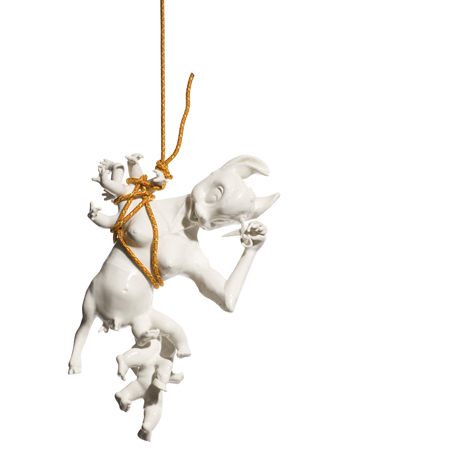
Shh… Craft is Golden! by Danish Crafts
Milan 09: a group of 12 designers from Denmark will exhibit work as part of an exhibition called Shh… Craft is Golden! in Zona Tortona, Milan, next week.
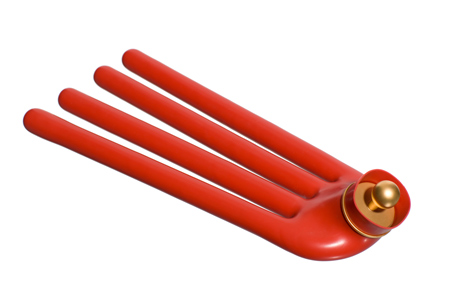
Organised by Danish Crafts and curated by Karen Kjærgaard, the show includes hot water bottles in five different shapes designed by Ole Jensen (above), made by repeatedly dipping a clay shape into liquid rubber.
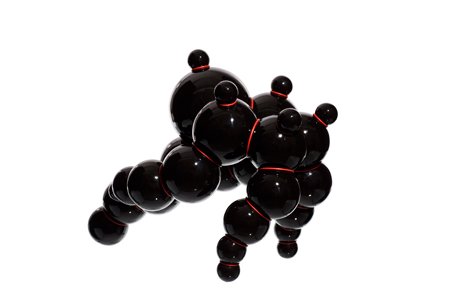
Danish Crafts organised the Mindcraft exhibition at 100% Design last September, featured in our previous story.
Above: TIED - POWER by Steen Ipsen
TIED - POWER is modelled stoneware with a black high-gloss glaze and red leather. In this work, which is constructed from spherical shapes, Steen Ipsen aims for an expression of forceful vitality. However, the work also strives for a graphic simplicity, underscored by the red laces, as well as a sensual undertone that speaks to the beholder's imagination. His vision was to "create a modern work in a design that is compatible with many architectural and interior design contexts, but which also expresses history and elements of primeval power."
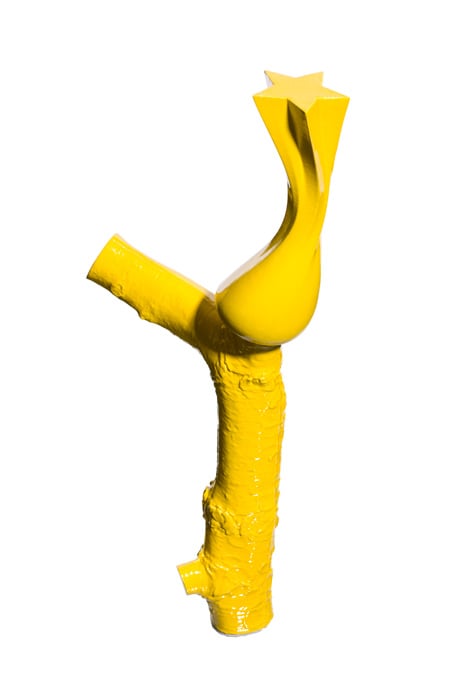
The exhibition on Via Savona opens on Tuesday and continues until 26 April.
Above: Starshot Implosion by Martin Bodilsen Kaldahl
Starshot Implosion is a complex ceramic object, a form encounter between a segment of a tree branch and a dynamic digital form based on a simple star. The object's expression was achieved by linking a digitally generated form with a certain visible figurative reference to a cast of a natural component (a segment of a tree branch). With a humoristic/absurd undertone, the resulting form expression postulates a connection between a natural archetype and the geometrically based pop universe of the digital form, unfolding its potential meanings in this field of tension.
"My objects arise through ongoing experimentation, digital as well as analogue, and operate in a field where there is no specific narrative.
Only the potential for one - depending how the individual visual elements come together in the beholder's mind," says Martin Bodilsen Kaldahl in reference to his own working process, which begins with a digital design that is 3D-printed in plastic, before it is shaped in plaster and cast in clay.
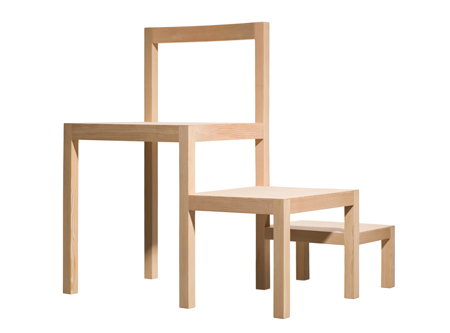
Captions are provided by the designers.
Above: Pluralis by Cecilie Manz
PLURALIS is a chair in the plural form! In Cecilie Manz' own description, PLURALIS is "an archetypal chair with an appendix, the two elements fused and inextricably linked. A chair composition for three persons." It is made in solid wood, either natural or painted white/black. The chair is produced exactly like any other wooden chair: planed, milled, polished, etc. Is it the dining room chair that has the little ones clinging to its legs, or is it the little one that has the big ones on its back? "As a piece of furniture it's a versatile mystery with its many directions and its insistence on extensive accommodation all around," says Cecilie.
PLURALIS is produced in a limited edition by Mooment.
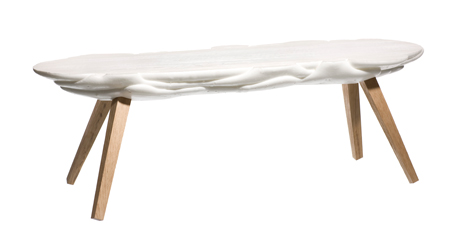
Above: Woody Benchmark by Christian Flindt
Woody Benchmark consists of sketches and casts in wood and polyurethane plastic. It is a bench, which is the outcome of plastic casts on a wooden work bench. The legs were milled in wood and then stuck into the plastic mass. The result is a soft and comfortable bench. The word benchmark derives from cabinetmaking. When a cabinetmaker needed specific dimensions he made a mark in his workbench.
The project was created in collaboration with furniture conservator Teis Abrahamsen, Frederiksborg Castle with the specific goal of combining wood and plastic. It is the first time Flindt has ever worked with wood and every bench is different from the others. The outcome depends on how the foam mixture runs off and is formed.
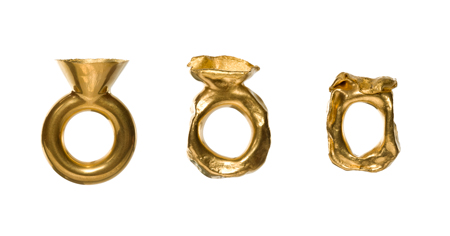
Above: GoldJewelleryGoldJewelleryGoldJewelleryGold... by Kim Buck
Throughout the ages, jewellery has been viewed as an investment object, not appreciated because of its design and craftsmanship but merely because of the raw materials. Kim Buck seeks to illustrate this through his finger rings in fine (24-carat) gold. Through use, the shape of the rings will be deformed beyond recognition due to the softness of pure gold. The shape will be lost over time, and the owner is left with the raw material - pure gold. The rings are cast in a unique and secret process developed by Kim Buck.
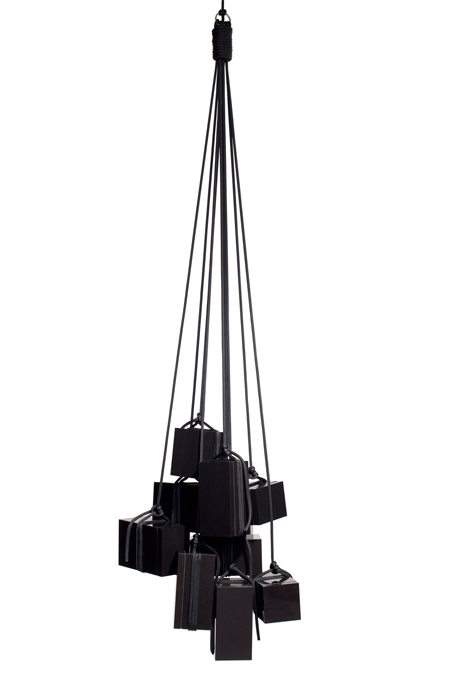
Above: Bunch of Boxes by Ditte Hammerstrøm
Bunch of Boxes is a series of small boxes that combine to make up a set of hanging drawers. A piece of furniture for small keepsakes and therefore a piece of furniture that can always be expanded with additional boxes as needed. Bunch of Boxes is made of lacquered wood and rope. This is a piece of furniture that is capable of expanding and growing as need dictates. The work is sponsored by Montana.
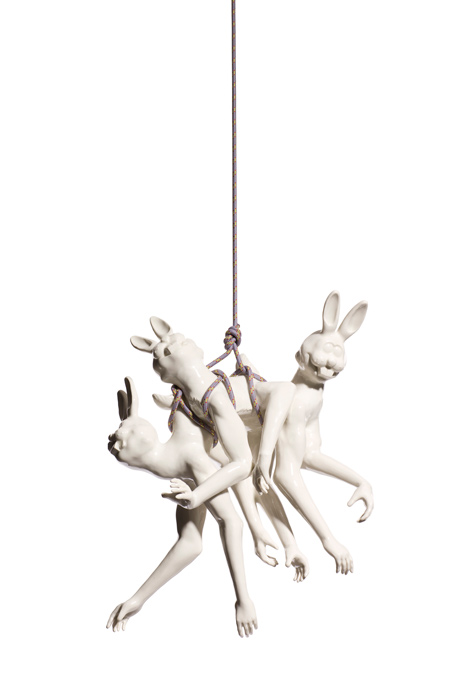
Above: Silence! - In the event of a divine presence by Louise Hindsgavl
For the 2009 Mindcraft exhibition, Louise Hindsgavl has created five large porcelain figurines. Three of them are suspended from ropes, while the remaining two observe them in silence.
"With this group of porcelain figurines, I wish to incorporate the awareness that laboratories carry out magnificent craftsmanship, as skilful people seek to grasp how life is created and what potential for additional development this implies. At the same time, I wish to sound a warning against us becoming tacit, unquestioning spectators, accepting anything simply because it's technically feasible," says Louise Hindgavl about the figurines.
To her, craftsmanship has many permutations, and it covers concepts that go well beyond craft. It is well-established that a cabinetmaker can be a good craftsman, but we are probably less aware that science also requires good craftsmanship in the application of theories. In her present works, Louise Hindsgavl seeks to highlight exactly this aspect of craftsmanship. Silence means reverence. Reverence for what might be possible when strong forces and skilful craftspeople are involved. However, it is also problematic if our unquestioning enthusiasm about the possibilities causes us to let these possibilities run amok with our inventiveness.
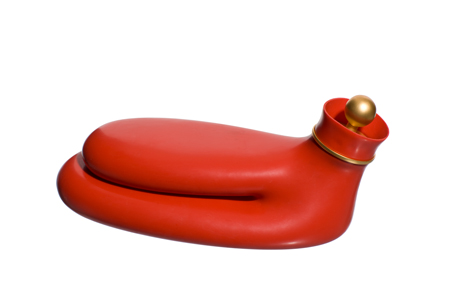
Above and second image: Hot Water Bottle by Ole Jensen
Hot Water Bottle is a soft container that can be filled with hot water and placed on or near the body. It is typically used to ease stomach or muscle pain. "Or if you just feel under the weather and need some warmth," says Ole Jensen, adding that the product is probably "particularly relevant in cold climates and difficult times."
The product is made in natural rubber and metal by repeatedly dipping a clay shape into liquid rubber. The rubber is treated with a thin layer of silicone for durability. The stopper is handmade in gold-plated brass with a screw thread closure. The hot water bottles are made in five different shapes in brown or red.
Hot Water Bottles are produced by Latex One and Lars Glad in collaboration with Rasha Sager & Saxenfelt Natural Rubber Products.
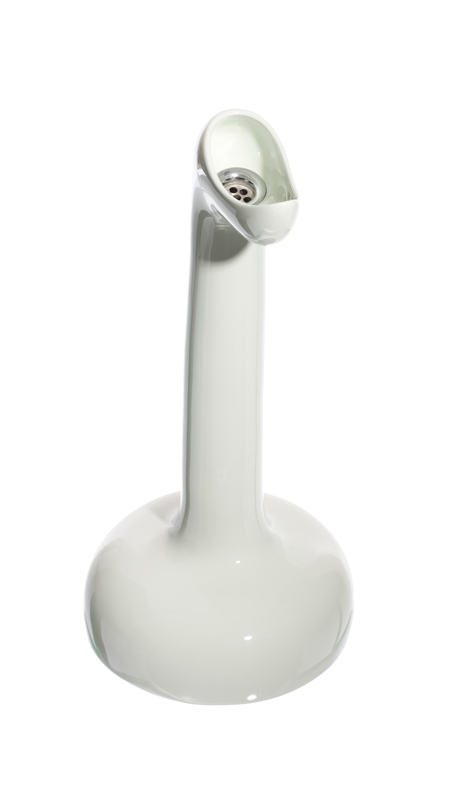
Above: Feminoir by Christin Johansson
Feminoir is based on the notion of creating a pissoir or urinal for women. In Christin's own words, "Why shouldn't women be able to pee quickly and easily, standing up?" Feminoir is handmade in earthenware, which is fired at 1,100 degrees Celsius and subsequently polished and coated with car paint.
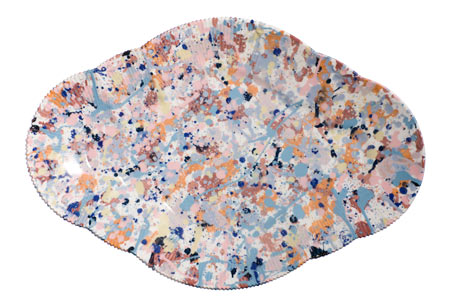
Above and below: Splatterplatter by Louise Campbell
After three years of intense collaboration with Royal Copenhagen on the development of a complete dinnerware (named Elements), Louise Campbell turns her back on the commercial mindset for a while and instead attacks the material head on without knowing the outcome beforehand. She has two months, a workshop space and a number of assistants, and now it's time to play and to make a mess! The porcelain mass is dyed, and then she pours, spills and drips it into plaster moulds - with large gestures but without losing her grip.
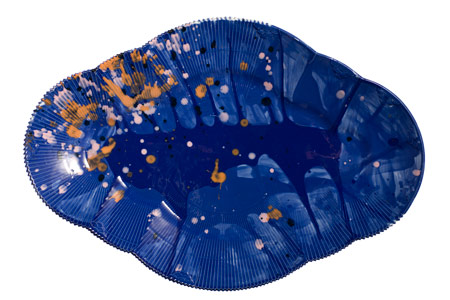
Elements provides the framework for the intense splatter project, as Splatterplatter uses a very large and highly detailed mould from Elements. Thus, the product goes from being reasonably commercially manageable to being strictly one-off and out of control. The working process for dyed porcelain is completely unpredictable. Every dye affects the mass in a different way, and firing and glazing lead to additional surprises. That is why it is so crucial to not even try to control the process but instead let the colours do exactly what they want. "One of my favourite things is a table or a palette where a bunch of colours have been mixed and spilled. Usually, this accidentally decorated surface is far more beautiful than what the colours were intended for. Splatterplatter marks a liberation from the careful planning of patterns. Sometimes, it's good to leave things up to chance, even for a designer." Splatterplatter is sponsored by Royal Copenhagen.
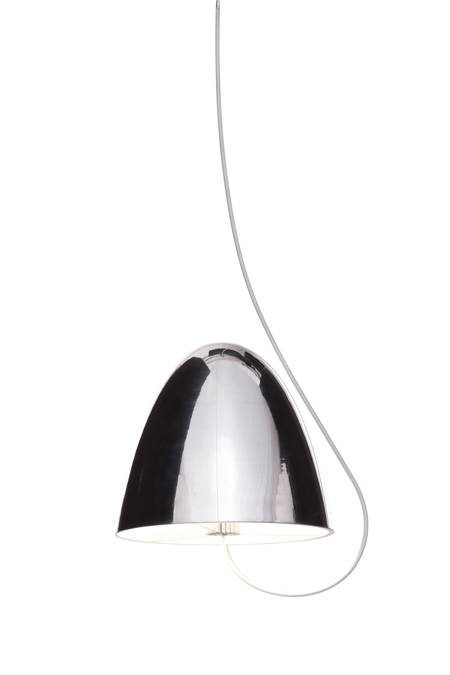
Above: Wet Bell by Salto & Sigsgaard
Wet Bell is an untraditional pendant lamp made in steel and aluminium, where a sheet of aluminium has been pressed, and a steel pipe bent to produce the end-result. In Salto & Sigsgaard's own words, Wet Bell is a lamp that provides good lighting, and which is true to its LED light source. Wet Bell is another term for a diving bell.
Salto & Sigsgaard's joint exhibitions include "Mon beau sapin" in Paris (2006) and "NOSY-T" at Form/Designcenter in Malmö (2008). They have both received several prestigious grants and exhibited in a number of venues in Denmark and abroad. Design, according to Salto & Sigsgaard, means "taking something and improving on it." They do not believe in inspiration but in diligence and carefully considered and relevant ideas.
Salto & Sigsgaard work in almost all conceivable materials in an analytical work process that is not focused on ‘styling'.
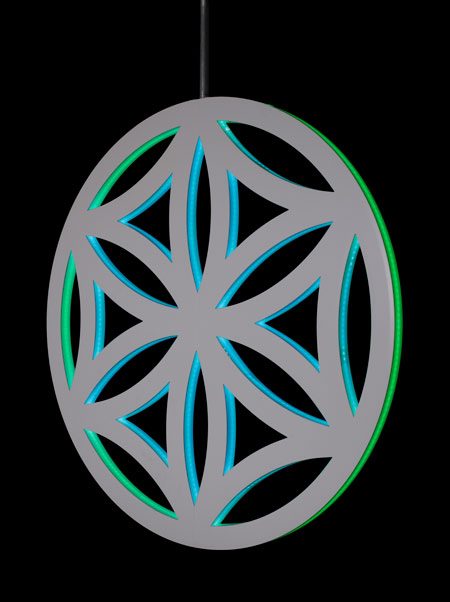
Above: Circle light by Astrid Krogh
Circle Light is a light mobile or light ornament. The light mobile spins around its own axis, slowly changing colour, as a meditative light ornament for the home or room. It is made with LED lights in laser-cut aluminium with glued-on acrylic fronts, where the LED technology is concealed inside the form itself.
The inspiration for Circle Light came from an ancient pattern called ‘Flower of Life'. The Flower of Life pattern consists of circle segments forming a flower, which is believed to symbolise so-called sacred geometry. Thus, the light ornament represents ‘perfect form', proportion and harmony ... nothing less. In Astrid's words, "Circle Light is intended as a symbolic and visual expression of the way in which circles of life move into each other."
Here's some text from Danish Crafts:
--
Danish Crafts’ debut in Zona Tortona last year was such a resounding success that Danish Crafts is present once again in Zona Tortona during the Milan Design Week. This time with the exhibition “Shh ... Craft is Golden!”, which showcases 12 of Denmark’s finest craftspeople and designers. The exhibition is on display 21 through 26 April 2009 in Zona Tortona, Via Savona 55a.
Danish craft and design is currently in a unique position and enjoys great international recognition and demand. With the exhibition “Shh … Craft is Golden!”, Danish Crafts wishes to introduce the world to the huge potential, the gold, to be found in Danish craft and illustrate the great rewards awaiting anyone wishing to explore the world of craft. The title refers to the old adage, 'speech is silver; silence is golden', and thus, the exhibition highlights the values inherent in craft.
In this case, the gold consists of 12 reflective, mirroring, luminescent, rotating, crawling and, not least, provoking works that speak for themselves with great integrity thus demonstrating that this is the real thing.
MINDCRAFT x 2
This year, 12 craftspeople and designers from Denmark’s absolute elite present 12 completely new works, and as in last year’s MINDCRAFT exhibition, the works on display represent more than just material and technical skill. Characteristically, all the works are as much an artistic comment to the world we live in, and they all present the beholder with content rather than surface.
Last year, Danish Crafts’ exhibition MINDCRAFT had more than 10,000 visitors, and in September 2008 when the exhibition was presented at 100% design in London, MINDCRAFT received the award for “Best Contribution to 100% design”.
Tied powercraft, circle lights and a bunch of hanging drawers
The 12 craft artists participating in this year’s exhibition are:
- Furniture designers Louise Campbell,
- Cecilie Manz,
- Ditte Hammerstrøm,
- Salto & Sigsgaard
- and Christian Flindt
- Textile designer Astrid Krogh
- Ceramicists Louise Hindsgavl,
- Martin Bodilsen Kaldahl,
- Christin Johansson
- and Steen Ipsen
- Goldsmith Kim Buck
- Designer Ole Jensen
Internationally acknowledged designers in “Shh … Craft is Golden!”
The designers selected for this exhibition are all internationally acknowledged designers with professional design training.
Furniture designer Louise Campbell creates designs for the Italian furniture maker Zanotta, among others, and for several world-renowned Danish manufactures including Royal Copenhagen, Holmegaard, Louis Poulsen and Hay Cph.
Furniture designer Kasper Salto creates designs for the world-renowned Danish furniture manufacturer Fritz Hansen, and furniture designer Ditte Hammerstrøm’s clients include the Danish furniture manufacturer Erik Jørgensen.
Ceramicist Ole Jensen is known around the world for his washing-up bowl in rubber, which was launched by Danish Crafts and is now manufactured by Normann Copenhagen. Since the launch, the bowl has become a world-wide success. Ole Jensen also designed the series “Ole” for Royal Copenhagen.
Designer Cecilie Manz is known for the lamp Caravaggio, which she designed for the Danish lamp manufacturer Light Years, as well as the glass series Minima for Holmegaard.
Goldsmith Kim Buck designed the ring series Eclipse, Centenary and Nordic Summer for Georg Jensen.
The exhibition is curated and designed by Karen Kjærgaard.
Danish Crafts is a national information centre that aims to highlight, promote and increase turnover for Danish crafts in Denmark and abroad. Danish Crafts is an independent institution under the Danish Ministry of Culture.
See all our stories from Milan in our special MIlan 2009